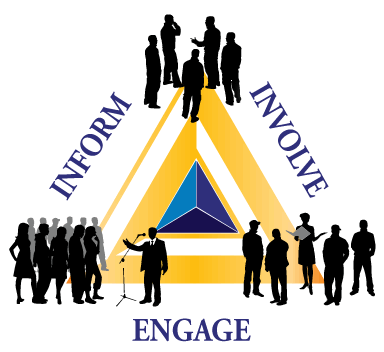Managing Organizational Communication
Overview
Communication is a vital management component to any organization. Whether the purpose is to update employees on new policies, to prepare for a weather disaster, to ensure safety throughout the organization or to listen to the attitudes of employees, effective communication is an integral issue in effective management. To be successful, organizations should have comprehensive policies and strategies for communicating with their constituencies, employees and stakeholders as well as with the community at large.
The following communication topics are discussed in this toolkit:
- The impact of effective and ineffective communication on the organization and its employees.
- How to build an effective communication strategy.
Communication Strategy
The Importance of a Comprehensive Communication Strategy
Most HR professionals and organizational leaders agree that linking corporate communication to business strategy is essential to effective and consistent business operations. With a formal and comprehensive communication strategy, organizations can ensure that they:
- Communicate consistent messages.
- Establish a recognizable employment brand.
- Deliver messages from the top that are congruent with the organization's mission, vision and culture.
The impact of effective communication
Effective communication may contribute to organizational success in many ways. It:
- Builds employee morale, satisfaction and engagement.
- Helps employees understand terms and conditions of their employment and drives their commitment and loyalty.
- Educates employees on the merits of remaining union-free (if that is the organization's goal).
- Gives employees a voice—an increasingly meaningful component of improving employees' satisfaction with their employer.
- Helps to lessen the chances for misunderstandings and potentially reduces grievances and lawsuits.
- Improves processes and procedures and ultimately creates greater efficiencies and reduces costs.
The impact of ineffective communication
Ineffective communication may increase the chances for misunderstandings, damage relationships, break trust, and increase anger and hostility. Ineffective communication may stem from poorly aligned strategy, a failure to execute the strategy, use of the wrong communication vehicle, bad timing, and even nuances such as word choice or tone of voice. See The Cost of Poor Communications and The 7 Deadliest Communication Sins.
Two-way communication
HR professionals may initially think of communication mainly in the context of delivering messages to employees about business issues, policies and procedures, but two-way communication plays an essential role in a comprehensive communication strategy. Listening to employee issues and concerns builds loyalty and drives improved productivity. Organizational leaders can learn through listening about issues or concerns before they become formal grievances or lawsuits. They can also discover potential employee relations issues and learn about attitudes toward terms and conditions of employment. See Three Steps to Turn Up Your Listening Skills and Open and Transparent Communication.
Building a Communication Strategy
To develop a communication strategy, employers should begin by linking communication to the strategic plan, including the organization's mission, vision and values; its strategic goals and objectives; and its employment brand.
Effective communication strategies:
- Safeguard credibility to establish loyalty and build trust.
- Maintain consistency to establish a strong employment brand.
- Listen to employees and to members of the leadership team.
- Seek input from all constituencies.
- Provide feedback.
- Prepare managers in their roles as organizational leaders.
A communication strategy includes the following elements:
- Highly effective strategies that are often top-down, with senior management setting the tone for a cascading series of messages.
- A budget that allows for the use of various types of communication vehicles depending on the message to be delivered and any unique issues associated with it.
- A process by which leaders evaluate any particular situation driving the need to communicate and from which key messages will emerge.
- A method for generating feedback and using it to shape follow-up messages.
- A customized delivery approach with communication materials that are easy to understand.
Constituencies
Everyone in the organization has a role to play in communication:
- The CEO and senior managers are ultimately responsible for setting the tone and establishing organizational culture. Key leaders should be coached on their role in ensuring effective companywide communication.
- The HR professional and communication leader also have critical roles, especially in challenging economic environments.
- Managers are responsible for daily communication with their employees and for relating to their peers and colleagues.
- All employees have a responsibility to voice concerns and issues, provide feedback, and listen effectively.
Training
Communication training may encompass any number of topics, including:
- Company communication policies.
- Effective writing and presentation skills.
- Train-the-trainer initiatives.
A strong training component will not only equip leaders to communicate effectively with their teams and other organizational leaders, it will also help them understand the appropriate communication channels and protocols.
Responding to employee issues
There is no better way to cause resentment among employees than to ask them for feedback and then fail to act in response to their concerns. Honest, constructive feedback from employees starts with trust and the understanding that employees can voice their concerns without fear of retaliation. See Employee Engagement Surveys: Why Do Workers Distrust Them?
Dealing with external media
External communications—including public and community relations—may also be a part of an organization's communication strategy. HR professionals, in conjunction with public relations professionals and top management, should develop formal policies and procedures for dealing with external media.
Measuring results
While organizations generally agree that measuring and quantifying results of communication plans are beneficial, this goal is difficult to accomplish. Given the elusive nature of communication data, determining a cost-benefit ratio, for example, may be challenging. Did the organization fare better because of the manner in which it communicated crucial information about a merger or acquisition? Was the impact of a reduction in force on morale mitigated by the way in which employees were told?
Despite the difficulty of doing so, organizations should strive to collect qualitative and quantitative information to evaluate their efforts:
- Qualitative data may include anecdotal evidence that employees' attitudes were improved after the handling of an emergency situation or that focus group information supported the strategy for communicating benefits changes to employees.
- Quantitative data may include measures such as turnover rates, productivity rates and employee satisfaction benchmarks, as well as use of employee service center options.
Source: SHRM



